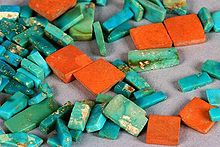
When setting out to purchase turquoise, it is important to know how much these precious stones will cost, what you should be willing to spend and what a standard turquoise price is. Fake turquoise can be a major issue if you are unprepared to deal with someone peddling imposter stones at a normal or marked up turquoise price.
Turquoise Price
There are a number of factors that influence turquoise price across the world. Having this information will help you determine what turquoise price you are willing to pay. Obviously when you think turquoise, the first thing that likely comes to mind is the color. In many instances, the shades of the stone will be the biggest factor in deciding what turquoise price you will be asked to pay.
The purity level in turquoise plays an enormous role in determining its value. Where the stone was discovered also is a factor when settling on a turquoise price. The condition of the stone and the level of which it needed to be treated will also help set the turquoise price.
Fake Turquoise
A number of stones claiming to be the real deal are actually fake turquoise that is being sold at a standard turquoise price. The most common stone associated with fake turquoise is howlite. Because of its white or grey natural appearance, howlite is treated with color dye and can look very similar to real turquoise and sold at a traditional turquoise price. Howlite also has a pattern that appears like a matrix found in turquoise.
Another common form of fake turquoise is called “African Turquoise.” This gem is actually jasper and it is an even harder stone than turquoise. Blue jasper is rarely discovered, as typically it’s naturally brown, green, red or yellow. Other forms of fake turquoise include faience, polymer clay and Utah, Vienna and Block turquoise.